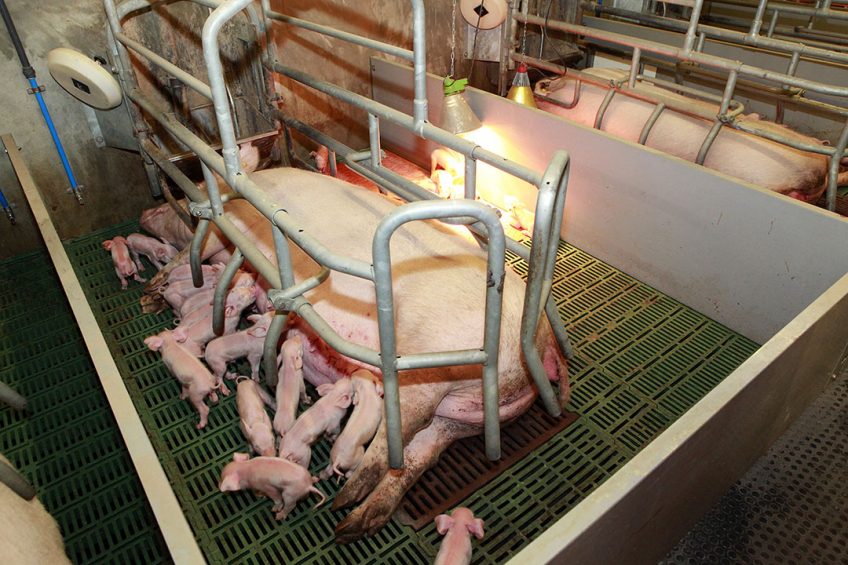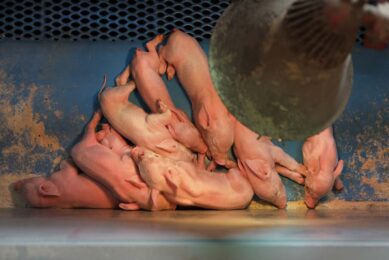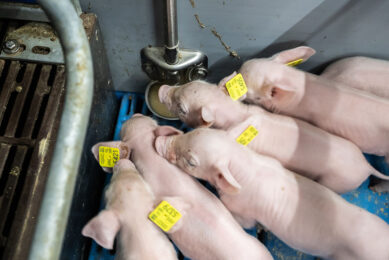Delayed weaning better for piglet welfare

More piglets per sow yields more income. This has been the trend for years and the simplest way to achieve it is to wean the piglets sooner rather than later. Piglets can be weaned at 21 days with specially designed piglet breeding spaces. Early weaning was the method of choice before animal welfare and reduction of antibiotics became more important. This is about to change.
The early weaning trend is losing ground to the trend of delayed weaning at around 5 weeks, or 35 days. However, delayed weaning can have a mental impact on the top performing farmer because the technical results drop. When the litter index decreases with 0.20 and the number of weaned pigs per sow decreases by 2, it may leave the farmer feeling rather deflated. With constantly chasing optimum performance, every momentary dip at the farm may feel like failure, a sow farmer also needs to be able to defend himself to other farmers and to the bank as well.
Using antibiotics
The public debate about pig mortality and the use of antibiotics accelerates the need for change. One part that has a positive influence on all of this is the weaning age. Research has shown that delayed weaning reduces stress and leads to more resilient piglets. The average weaning age in Scandinavian countries is 35 days and they boast the lowest use of antibiotics in Europe. However, Dutch research carried out by Wageningen Livestock Research shows that piglets that are weaned later, at 7 or 9 weeks, show less unwanted behaviour, such as tail biting, ear sucking and flank biting.
Better Life label
The Dutch Society for the Protection of Animals wants to increase the weaning age within the production criteria of the Better Life 1-star welfare concept, after consulting with participants and retailers. Their current weaning criteria is 25 days with a minimum of 23 days. Society expects that not only specific meat segments will demand piglets that are weaned at 5 weeks. Larger parts of the Dutch domestic market will also ask for older piglets at weaning, because delayed weaning simply yields more results in fattening. Less health problems and increased growth, even reaching the line of 1,000 grams or more growth per animal.
Extra yield per piglet
Delayed weaning has health benefits, but how does the sow farmer get appreciation for doing this in practice? For piglets that are weaned at 4 weeks, a premium of 3% is given on the standard piglet price quoted in the Netherlands (BPP piglet quotation). Apart from the bonus per kilogram for heavier piglets, there is no standard tariff in the BPP for a higher surcharge for a weaning age of 5 to 6 weeks. Financial adviser Erik van der Hijden, from the company FarmAdvies, does not see any advantages in a set extra bonus for piglets that are weaned later. What is now negotiated as an added value in a surcharge, will be the base price next year, which means you are again falling behind. Van der Hijden calculated the piglet cost price if a sow farmer starts weaning 9 days later and reached the following conclusion: a piglet that is weaned at 5 weeks (35 days) instead of the regular 26, has a higher cost price of € 1.19 per piglet. This comes down to about € 0.13 per piglet per day.

Heavier piglets
Van der Hijden looks at the calculation from the perspective of the number of piglet spaces and assumes there are enough farrowing pens and spaces available. He also assumes that the piglets stay in the piglet barns just as long as they normally would and can be delivered heavier because of it. Because the piglets that are weaned at 5 weeks stay at the farm for 9 more days, they are heavier and yield more because of the surcharge per kilogramme. The current surcharge for a piglet on the Dutch market is € 0.80 per kg over 23 kg. According to Van der Hijdens calculation, sow farmers that wean 9 days later, would receive at least € 1 per kg compensation for their heavier piglets.
At the moment, farms that do not have enough space for piglets choose, to wean at 5 weeks, but Van der Hijden thinks it is applicable in many situations, especially when the sow farmer wants to deliver qualitatively better pigs. The technical results at the finisher farm do need to be visible, otherwise it will remain a gut feeling and will not lead to success. Delayed weaning is more feasible at closed finisher farms, especially when there is a shortage of piglet space and the surplus piglets would otherwise have to be sold.
Sow farm yield under pressure
Rick ter Haar of Topigs Norsvin has made a comparison in the Topigs Norsvin calculation model for a farm with 1,000 sows and 240 farrowing pens that switches from weaning at 26 days to 33 days. He assumed that nothing changed at the farm. In this case, the farrowing pens are the limiting factor. By weaning at 5 weeks with the existing 240 farrowing pens, only 40 sows per week can produce a litter instead of the 48 sows in a system that weans at 4 weeks. With an additional week group, 22 instead of 21, only 880 sows can be kept when weaning at 5 weeks, which means almost 13% less sows (Table 1).
Yield summary
|
Delayed weaning has advantages
Ter Haar sees the advantages of delayed weaning. The sows have more time to recover, the percentage of farrowing sows increase, along with the litter size. Experience shows that farms switching from weaning at 21 days to weaning at 28 days, see an increase of 0.5 piglets per litter. A piglet’s yield increases and the costs, such as piglet feed and health costs, go down. Still, the calculation is not positive. In the end, there is a negative yield of € 20.000 if weaning is delayed for a week. Of course it always remains personalised and will have to be viewed per farm.
Weaning at 5 weeks reduces stressKarel Vandamme supervises several companies that have started weaning at 5 weeks and he is enthusiastic about the results.
Which weaning age would you recommend sow farmers from a health perspective?“Normally, a piglet will only drink milk in the first 13 to 15 days of its life, provided that the sow has a normal to good milk production. It will consume little to no feed. This feed intake will sharply increase at the age of 3 to 4 weeks. Physiologically, there is a clear correlation between the weaning age and the height of the intestinal villi. At a later weaning age, the surface reduction for nutrient resorption remains limited, we detect more enzyme activity and there is less chance of weaning diarrhoea. With that in mind, I recommend a minimal weaning age of 4 weeks for the youngest piglet. This means we will need to wean at 5 weeks, which allows time for the use of foster sows.” Production results are a limiting factor for sow farmers who want to delay weaning. What are your experiences?“Loss of production in sow farming because of a lower litter index is often used as an excuse, but we do not see this in practice. The farms I supervise showed a similar production number, because the number of live piglets and the percentage of farrowing sows got better after switching to weaning at 5 weeks. One farm even reported an increase of 1 piglet in the number of weaned piglets per sow. The quality of the piglets at birth is visibly better and mortality after weaning decreases. Moreover, job satisfaction grows, because everything is a little easier.” What exactly is easier? What are the advantages of weaning at 5 weeks?“The weaning process is easier at 5 weeks. The later the piglets are weaned, the less stress the animals experience. The older piglets are heavier when weaned and therefore, less susceptible to infections. The infections are still present at the farm but give less clinical problems. Therefore, we see less problems with for example weaning diarrhoea, streptococci and post-weaning influenza. The use of antibiotics is little to none at these farms.” What effect does delayed weaning have on the finishers?“The better the piglet gets through the weaning period, the higher its growth. This decides the performance as a finisher. At the companies under my supervision, the finisher results are above 900 grammes of growth per day. With the right feed, ear and tail necrosis will be manageable from the perspective of improved gut health. |
 Beheer
Beheer





 WP Admin
WP Admin  Bewerk bericht
Bewerk bericht